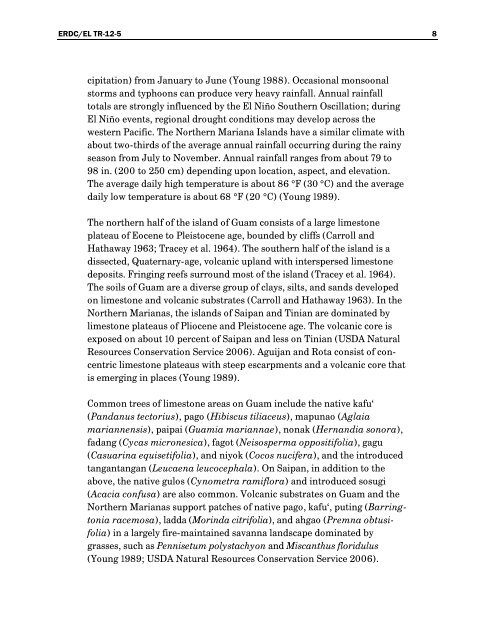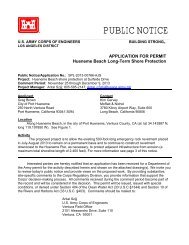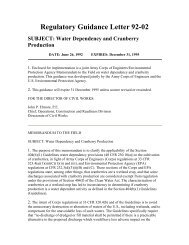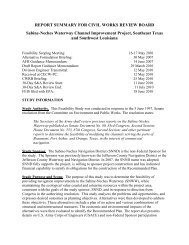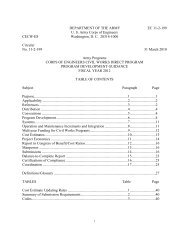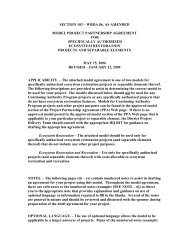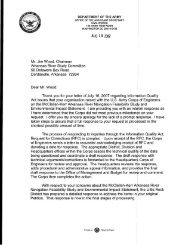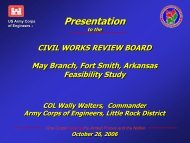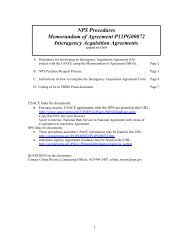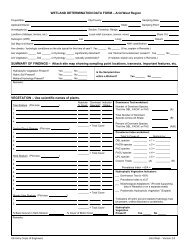Hawaii and the Pacific Islands - U.S. Army Corps of Engineers
Hawaii and the Pacific Islands - U.S. Army Corps of Engineers
Hawaii and the Pacific Islands - U.S. Army Corps of Engineers
You also want an ePaper? Increase the reach of your titles
YUMPU automatically turns print PDFs into web optimized ePapers that Google loves.
ERDC/EL TR-12-5 8cipitation) from January to June (Young 1988). Occasional monsoonalstorms <strong>and</strong> typhoons can produce very heavy rainfall. Annual rainfalltotals are strongly influenced by <strong>the</strong> El Niño Sou<strong>the</strong>rn Oscillation; duringEl Niño events, regional drought conditions may develop across <strong>the</strong>western <strong>Pacific</strong>. The Nor<strong>the</strong>rn Mariana Isl<strong>and</strong>s have a similar climate withabout two-thirds <strong>of</strong> <strong>the</strong> average annual rainfall occurring during <strong>the</strong> rainyseason from July to November. Annual rainfall ranges from about 79 to98 in. (200 to 250 cm) depending upon location, aspect, <strong>and</strong> elevation.The average daily high temperature is about 86 °F (30 °C) <strong>and</strong> <strong>the</strong> averagedaily low temperature is about 68 °F (20 °C) (Young 1989).The nor<strong>the</strong>rn half <strong>of</strong> <strong>the</strong> isl<strong>and</strong> <strong>of</strong> Guam consists <strong>of</strong> a large limestoneplateau <strong>of</strong> Eocene to Pleistocene age, bounded by cliffs (Carroll <strong>and</strong>Hathaway 1963; Tracey et al. 1964). The sou<strong>the</strong>rn half <strong>of</strong> <strong>the</strong> isl<strong>and</strong> is adissected, Quaternary-age, volcanic upl<strong>and</strong> with interspersed limestonedeposits. Fringing reefs surround most <strong>of</strong> <strong>the</strong> isl<strong>and</strong> (Tracey et al. 1964).The soils <strong>of</strong> Guam are a diverse group <strong>of</strong> clays, silts, <strong>and</strong> s<strong>and</strong>s developedon limestone <strong>and</strong> volcanic substrates (Carroll <strong>and</strong> Hathaway 1963). In <strong>the</strong>Nor<strong>the</strong>rn Marianas, <strong>the</strong> isl<strong>and</strong>s <strong>of</strong> Saipan <strong>and</strong> Tinian are dominated bylimestone plateaus <strong>of</strong> Pliocene <strong>and</strong> Pleistocene age. The volcanic core isexposed on about 10 percent <strong>of</strong> Saipan <strong>and</strong> less on Tinian (USDA NaturalResources Conservation Service 2006). Aguijan <strong>and</strong> Rota consist <strong>of</strong> concentriclimestone plateaus with steep escarpments <strong>and</strong> a volcanic core thatis emerging in places (Young 1989).Common trees <strong>of</strong> limestone areas on Guam include <strong>the</strong> native kafu‘(P<strong>and</strong>anus tectorius), pago (Hibiscus tiliaceus), mapunao (Aglaiamariannensis), paipai (Guamia mariannae), nonak (Hern<strong>and</strong>ia sonora),fadang (Cycas micronesica), fagot (Neisosperma oppositifolia), gagu(Casuarina equisetifolia), <strong>and</strong> niyok (Cocos nucifera), <strong>and</strong> <strong>the</strong> introducedtangantangan (Leucaena leucocephala). On Saipan, in addition to <strong>the</strong>above, <strong>the</strong> native gulos (Cynometra ramiflora) <strong>and</strong> introduced sosugi(Acacia confusa) are also common. Volcanic substrates on Guam <strong>and</strong> <strong>the</strong>Nor<strong>the</strong>rn Marianas support patches <strong>of</strong> native pago, kafu‘, puting (Barringtoniaracemosa), ladda (Morinda citrifolia), <strong>and</strong> ahgao (Premna obtusifolia)in a largely fire-maintained savanna l<strong>and</strong>scape dominated bygrasses, such as Pennisetum polystachyon <strong>and</strong> Miscanthus floridulus(Young 1989; USDA Natural Resources Conservation Service 2006).


